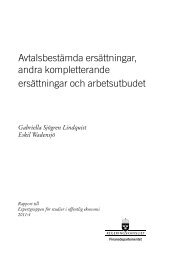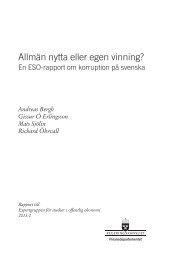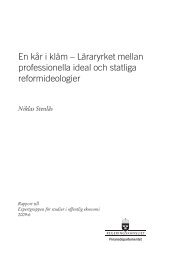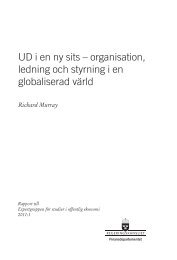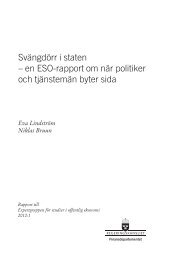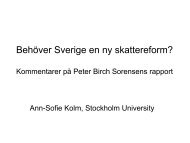Läs rapporten här - Expertgruppen för Studier i Offentlig ekonomi
Läs rapporten här - Expertgruppen för Studier i Offentlig ekonomi
Läs rapporten här - Expertgruppen för Studier i Offentlig ekonomi
You also want an ePaper? Increase the reach of your titles
YUMPU automatically turns print PDFs into web optimized ePapers that Google loves.
2012:5 Summary<br />
where the investments are important for commuting, and in<br />
particular in highly specialized labor markets. Productivity<br />
increases as a result of the Stockholm Metro will increase<br />
commuter benefits approximately 60 percent, because the Metro is<br />
widely used for commuting and improves matching in the labor<br />
market.<br />
Second, the reduction of car travel times in congested road<br />
networks, in response to new investments or policies, is<br />
underestimated by standard static transport models. The extent to<br />
which the benefits of the Metro are underestimated because<br />
congestion in the road network is not handled properly in the<br />
models is not assessed in the project. However, there is reason to<br />
believe that the underestimation is substantial.<br />
Third, congestion and capacity constraints in public transport<br />
are usually not handled in traffic models, although capacity<br />
constraints and congestion in public transport can and should be<br />
considered according to current national CBA guidelines. Hence,<br />
benefits of increased capacity in public transport (allowing the<br />
maximum number of passengers to increases) and benefits of less<br />
congestion on the vehicles and platforms are both often left out of<br />
the CBA. In the CBA of the Metro presented in this report,<br />
congesting and capacity benefits are extremely important and has<br />
been taken into account.<br />
The increase in capacity is an important benefit<br />
The present analysis demonstrates that the largest benefit of the<br />
Stockholm Metro is its high capacity. Travel time savings compared<br />
to the bus or tram is rather small. This conclusion provides insight<br />
as to where a potential expansion of the current Metro may be<br />
more beneficial than investments in other means of public<br />
transport: a basic condition is a high population density in the<br />
catchment area.<br />
A Metro can spread out settlements<br />
Much of the current land-use pattern of Stockholm has been<br />
planned integrated with building the Metro. We also simulate how<br />
the Stockholm land-use pattern could have developed had the<br />
15



